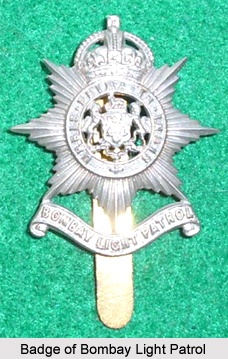 The Bombay Light Patrol was a cavalry regiment of the Volunteer Corps of the British Indian Army. It functioned under the administrative authority of the British Indian Auxiliary Cavalry Regiments. It was included as a part of the Bombay Army of Bombay Presidency. The Bombay Light Patrol was established in 1933. It was raised by the merger of the Bombay Light Motor Patrols of Bombay Contingent and the Bombay Light Horse.
The Bombay Light Patrol was a cavalry regiment of the Volunteer Corps of the British Indian Army. It functioned under the administrative authority of the British Indian Auxiliary Cavalry Regiments. It was included as a part of the Bombay Army of Bombay Presidency. The Bombay Light Patrol was established in 1933. It was raised by the merger of the Bombay Light Motor Patrols of Bombay Contingent and the Bombay Light Horse.
The military badge of the Bombay Light Patrol had an eight-pointed star which was surmounted by a crown. The Bombay Coat of Arms was inscribed in the centre of the star and was encircled by a hand. The motto of the unit "Urbs Prima in Indis" was also inscribed ion the badge.
This article is a stub. You may enrich it by adding more information to it. You can send your write-up at content@indianetzone.com



















